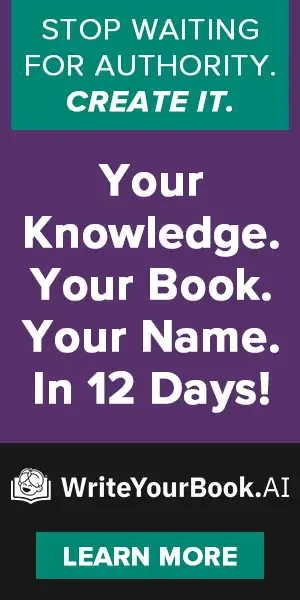(Quit Dreaming, Start Writing: Your Fast-Track Guide to Create and Publish Your OWN Book Fast!)
 Writing a book may seem like a pipe dream, especially for busy professionals.
Writing a book may seem like a pipe dream, especially for busy professionals.
However, experience has taught me that anyone can break the process down into eight straightforward steps from concept to publication. By following these steps, you can choose the tools and strategies – whether traditional or AI-driven – to create your book’s content quickly and efficiently, allowing your authentic message to shine through.
Step 1: Define Your Audience
The first step to writing your book is to clearly define your audience.
Who are you writing for, and what are their needs?
Understanding your target audience will shape your content and focus. Ask yourself, “What are their pain points? What do they want to achieve?”
Creating a book that addresses your audience’s desires and challenges ensures that you provide true value.
For example, if you are writing a business book intended for new entrepreneurs, think about their common struggles, such as finding funding, marketing their ideas, or managing their time.
This focus on THEM will not only guide your content, but it will also help you create a book that resonates and impacts your readers.
Step 2: Outline Your Book
Once you know your audience, it’s time to outline your book.
Planning out your content is crucial; it acts as a roadmap guiding you through the creation process.
Decide what topics you will cover and in what order. For instance, if your book helps new entrepreneurs find funding, you might start with an introduction to different funding options, followed by chapters on how to pitch to investors.
An outline can be as simple or detailed as you need it to be, but the main goal is to visualize the flow of your content. This clarity will make the writing process smoother and help you avoid getting stuck or sidetracked (or worse, give up!).
Step 3: Order Your Book Cover NOW
Now, here comes an essential step that might seem a little early in the process: ordering your book cover in advance.
While it may seem premature, having your cover ready when your manuscript is finished will save time AND provide a shot of motivation. Visualizing your completed book will shift your mindset from dreaming about writing to genuinely committing to the process.
Also, hiring a graphic designer – or utilizing AI design tools – early in the process avoids the last-minute stress of waiting on the cover before you can publish.
Step 4: Create the Content
Step four is where the magic happens: content creation.
Designate time in your schedule to focus solely on creating your content. Whether you’re jotting down ideas by hand, dictating, or typing away on a computer, put your head down and create. This is about getting your ideas on the page – don’t worry about making it perfect during this phase.
Set a time in your calendar. Set a timer to hold yourself accountable. Get it out of your head as fast as possible.
Remember, the aim here is output, and you can refine your work later, so allow your creativity to flow freely.
Step 5: Edit Your Content
Editing is often where most authors stumble. However, if you take the time to review while writing, you’re already ahead of the game.
Edit as you go… not in one big lump at the end. Focus on grammar and punctuation, not on major restructuring. If you’ve outlined and planned your content effectively, you shouldn’t need to do any more than that.
Step 6: Add Supplementary Elements
After editing, it’s time to add supplementary elements that round out your book and make it a “real” book.
Include items like a copyright page, a disclaimer, a dedication, and an author bio. Think of these as the finishing touches that give your book its professional flair.
Even if they may seem minor, these elements enhance the overall reading experience and provide credibility to your work. You want your readers to feel that they are absorbing a polished and thoughtful product.
Step 7: Format Your Book
Formatting is the next step, and it’s essential for both eBook and print versions of your work.
It’s fairly easy to format the ebook version of your book as you go through the process. As you create each chapter you can simply format it for publication in a main document. I typically format mine directly in Word, but you can use any word processor, including Google Docs, to do it.
Publishing in print involves using formatting software or hiring a professional to ensure that your book looks as good as possible once it hits the shelves.
Step 8: Upload and Publish
The last step in the process is very anti-climactic: uploading and publishing your book. If you’ve followed the previous steps, the publishing process should be relatively straightforward. You will essentially copy and paste your title, book description, keywords, and other required information into the publishing platform of your choice (usually Amazon).
Once you upload your cover image and book file, you’re done!
Moving Forward
Once you understand these eight steps, writing your book becomes less intimidating and much more achievable. With a structured, thoughtful approach, you can select the tools, processes, and strategies that work best for you – be it AI tools, traditional writing methods, or a combination of both.
The key is to find a method that allows your authentic voice and ideas to shine through.
Now, it’s time to stop wishing and start writing. So, grab your pen, or open your document, and let’s get started!
Ready to Write Your Book Faster? Don’t just dream about writing your book—make it a reality! Join the early notification list for our next “Write Your Book” challenge and turn your ideas into a published work faster than you ever thought possible. Sign up now at WriteYourBook.ai!
Facebook • Instagram • Twitter • LinkedIn • Pinterest • Podcast • TikTok • YouTube • LinkTree







Leave a Reply